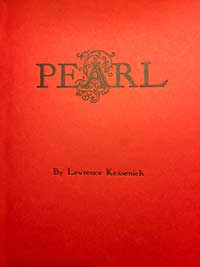 *
*
Review by Dennis Daly
Masked by its modest size and critically unconsidered, at least until now, because of the small number of available copies, Pearl, Lawrence Kessenich’s new chapbook, spellbinds the reader both as a commentary on Nathaniel Hawthorne’s The Scarlet Letter and, in its own right, as a compilation of compelling and elegant poetry.

Pearl
By Lawrence Kessenich
Letterpress Book Publishing
Oak Grove, Minnesota
125 Numbered and Signed Chapbooks
21 Pages
Besides the exquisite simplicity of the book’s design, Pearl astounds with a life-affirming passion rarely exhibited in contemporary American verse. Kessenich constructs his poems solidly, but somehow the spirit of their subject/narrator hovers over his whole collection, seemingly moving from piece to piece. The poet includes five interludes of prosaic Hawthorne-speak, which knit the poems together and elucidate the strange personal connection between Hawthorne and the most impish of his fictional characters.
Pearl is, of course, the illegitimate child of Hester Prynne, The Scarlet Letter’s protagonist. The poet borrows Pearl’s story and employs her as his reminiscing narrator. Early in Kessenich’s collection the poem On the Scaffold appears, in which Pearl and Hester reunite with Pearl’s minister-father, Arthur Dimmesdale, on the town’s scaffold. Pathos and guilt compete for dominance. The heartfelt scene touches with its possibilities of redemption. But Dimmesdale, exhibiting a weak character, falters. Pearl remembers the moment,
But I was not to be denied my father’s embrace.
He did not lift me to his breast, however, only
took my hand and stood there silently, a secret
rehearsal for a play that would not be performed,
a dumb show of love and remorse. “Minister!”
I challenged him, “Wilt thou not stand here with my mother
and me, tomorrow noontide?” Without consideration,
he replied, “Nay; not so, my little Pearl,” trembling
like a schoolboy—and in that instant ceased to be my father.
In Hawthorne’s original story, Pearl turns wild-child, unwittingly tormenting her mother. That author pictures her tossing wildflowers at her mother’s bosom. The objective of this juvenile game is hitting the scarlet letter emblazoned there. Innocence can often morph into unintended cruelty, that’s the way of the world, both Hawthorne’s and ours. Kessenich portrays Pearl lamenting her childhood mischief,
… We never spoke of what I did to you
that blazing afternoon, but I do dream
of being you, and feel each flower strike
my heart like a pistol held at point blank.
Many were convinced I was possessed,
and in that moment I most surely was,
the devil’s hand tearing live flowers from
the earth and turning them into weapons.
It is a wonder that I did not burst
your heart…
Spectral evidence convicted the witches of Salem. One could argue (and some have) that the New England Puritans repressed creative impulses in such a way that those same phenomena sometimes reappeared as malignant and negatively efficacious. A little hysteria added to that devil’s brew and tragedy ensued. Judge Hathorne, Ha(w)thorn’s forebear, aided and abetted by the best intellects of his time and place, presided over that dismal historic episode. Many of Hawthorn’s characters, by their words and actions, indirectly harken to this dark and personal theme. Kessenich mulls over the other side of that metaphysical coin, portraying a mature Pearl as a successful playwright, considering her art’s spectral origins,
…I have
peopled my own landscapes as long as I remember.
They are the appendages with which I reach out
to the world. Mr. Cruikshank tends to the sweet lambs
of my heart, while Mrs. Araby delves into
the exotic and arcane. Sgt. Bindlestaff defends
my honor, while Miss Honeypot lures handsome men.
I live a solitary life, but I am never
alone. I dine with Princess Paliver, play cards
with the Duke and Duchess of Quoits, drink wine
and smoke cigars with the dangerous Mr. Rakehell.
The ancestors of those colorful figures adorned
low branches in the forest beside my mother’s house,
sat, stood, kneeled, and ran at my command…
After the introductory Custom-House section, The Scarlet Letter proper opens with an odd but very pertinent description of a wild rose bush growing next to the prison door where condemned criminals were housed. Contrasted with its dismal Manichean surroundings, the bush introduced sweetness, fragrance, and fragility to seventeenth century Boston. Kessenich’s piece entitled Blossom expands on Hawthorne’s metaphor. Here Pearl blossoms as she speaks,
I create no characters like those in Puritan
lesson books, wooden figures representing Piety,
Evil, and little else betwixt. I take a cue from my
Creator, plant my garden with a dizzying variety
of personalities and physical types: crying fat men,
self-indulgent ascetics, ladies plumed like exotic birds,
men who define themselves by amorous conquests.
It is a rich, perplexing world that cannot be reduced
to obedience and self-denial, any more than a rose bush
can be told when to bloom and in what color. Trim us
too severely and we will grow back twice as large, thrice as bright.
Inseparable as Kessenich’s remarkable poems are, I still have favorites. One of them, Silence, speaks to the very nature of artistic endeavor. The poet has Pearl join the Quakers in later life as part a continuum of solitariness and internalized rebellion. Ensconced in this silence, she creates a more perfect (some would say exotic) world from the detritus of her flawed and former society. Waiting and listening lends themselves to creation. And creation heals. Pearl explains further,
it is silence I crave, all the goodly Quakers
lined up on meetinghouse benches—talkative
shopkeepers, chatty housewives, poets who love
to declaim—lips sealed, waiting for God to speak
to them or move them to speak, humbly and briefly.
Working among actors who love the sound of
their own voices, this reticence is a balm.
At meeting, Quakers weigh and value every word,
As I do when I write. Silence rules my process.
I, too, wait upon Divine inspiration—or, at least,
upon the Muses—before I dare bring words into
the world. Even with that, my Quaker elders
warn me that I wax too clever and profane. It is here
that we part company. For I believe that God
is likely to be amused at us as He is
to be wroth…
Upon reading Kessenich’s Pearl, a resurrected Nathaniel Hawthorne, I believe, would approve in silence, with a solemn nod and then, perhaps, a wink.
You can find the book at www.lawrence-writer.com.















Very well done!
The review makes me really want to read and buy this book.